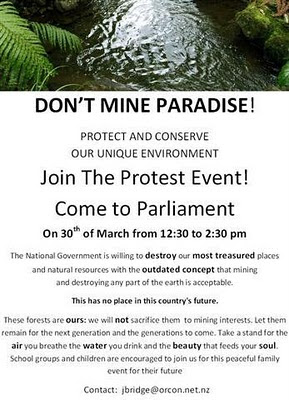I have just finished watching a programme about the immense lengths to which dedicated people have gone to protect vulnerable populations of native birds in New Zealand. That effort is both awe-inspiring and humbling.
It’s also a painful contrast with the National-led Government’s plans to open up New Zealand’s National Parks and other high-value conservation lands to mining.
The very fact that National launched these plans – as parts of their efforts to turn us into a tiny, ersatz Australia – shows that John Key’s Government, quite apart from their lack of commitment to protecting our environment, has a lot to learn about political management.
John Key was still a political novice when he became Prime Minister. He showed his political inexperience when he took on the post of Minister of Tourism as his “play portfolio”. He probably thought that this would give him equally good opportunities to travel around and open shiny facilities in beautiful places. Instead, it has landed him right in a brewing political storm.
See, the problem with being Minister of Tourism is that it makes you the public face of New Zealand’s elaborate and costly “100% Pure”, “Clean and Green” international image. New Zealand makes a lot of money from tourists: according to Tourism New Zealand,
International visitors contribute $8.3 billion to the economy each year, which accounts for 19.2% of export earnings. During 2006, 2.4 million international visitors arrived in New Zealand.
This means that keeping that Clean and Green image going, even if it is much more about appearance than reality, is a major priority of the Minister of Tourism.
So, how to enhance Clean and Green? How about … oh, I don’t know … opening up National Parks and other areas of high conservation value to mining?
That bright idea was cooked up by Minister of Energy and Resources Gerry Brownlee and his mining industry mates. The plan is to let gold, and coal, and all sorts of other mining take part in our National Parks.
Despite Government promises of strict environmental controls, and claims that there might be $140 billion of minerals under the conservation estate, the history of the mining industry in New Zealand and elsewhere, teaches us that:
- Mining companies will try to avoid having environmental controls imposed on them. Where controls are imposed, they are often ignored or circumvented. Mines destroy the land, both directly (by digging it up) and indirectly (through tailings dams, pollution, building access roads – the list goes on).
- Mining companies often go bust, leaving the public (in this case, the grossly under-resourced Department of Conservation) to pay the tab for tens or hundreds of years of environmental remediation.
- Although mining jobs are well-paid, mining creates very few jobs.
- Even if $140 billion of minerals were to be extracted – itself wildly unlikely – only a very small percentage of that would end up in the public purse. Most of it would go into the pockets of a few private investors in New Zealand, and rather more from overseas.
Helen Clark, as Prime Minister, ran a tight ship, sometimes to the point of immobilization. John Key is the opposite. He lets Ministers run with their pet projects, and in this case, Gerry Brownlee has run into a whole heap of trouble.* The Nats took their mining proposals to focus groups and discovered, to their shock, that “middle New Zealand” didn’t much like the idea of New Zealand’s iconic public lands being dug up.
That forced John Key to pay attention to the political danger. Now, he’s running around trying to downplay the issue.
When a Government starts to back down, that’s the best time to ramp up the pressure on them. So if, like me, you believe that opening up National Parks and other areas of high conservation value to mining is irresponsible, short-sighted and ethically wrong, not to mention economically dubious, then here are some things you can do.
What You Can Do
Attend the protest if you’re in Wellington (see the poster above for details).
Send John Key and relevant Ministers an e-card telling him our National Parks are too precious to mine: http://www.forestandbird.org.nz/our-national-parks-are-too-precious-mine
Email him directly and tell him the same thing: j.key@ministers.govt.nz. If you live outside New Zealand, email John Key and point out that tourists don’t want to visit mine tailings.
Tell Gerry Brownlee where to get off: g.brownlee@ministers.govt.nz
In case you’re thinking “yeah, right, all these messages will go straight into the trash” – in New Zealand, that’s not true. I once worked in a Government department answering letters and emails from the public, and non-form messages did get read and responded to. (This means a personal email is more likely to get a reply than an e-card.) If you put your postal address in the email, you may even get a letter in response.
*A more Machiavellian view of John Key’s behaviour is that, by letting Gerry Brownlee run the pro-mining campaign, he has handed a bumptious Minister a long length of rope, and then watched Gerry Brownlee use it to hang himself (in the political sense). But John Key would never do anything like that, would he? He has such a nice smile.

